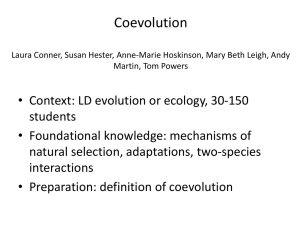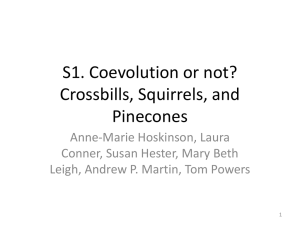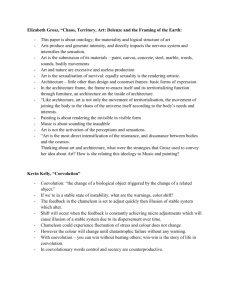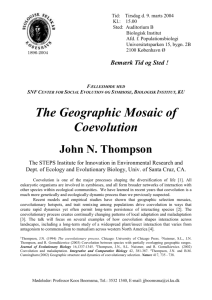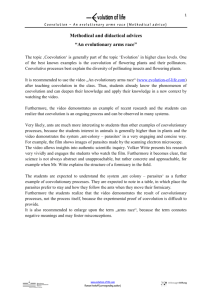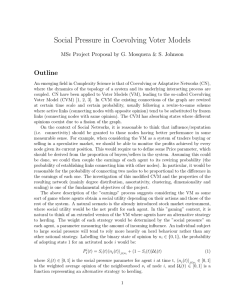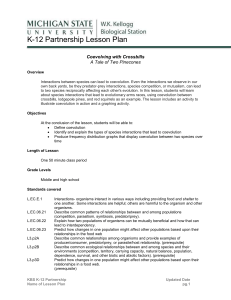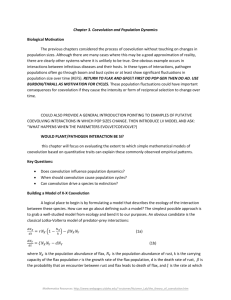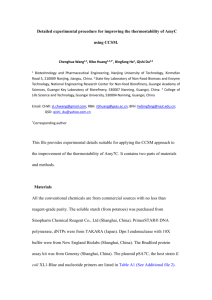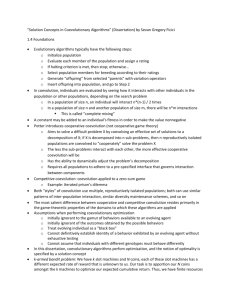Coevolution In-Class Powerpoint Presentation
advertisement
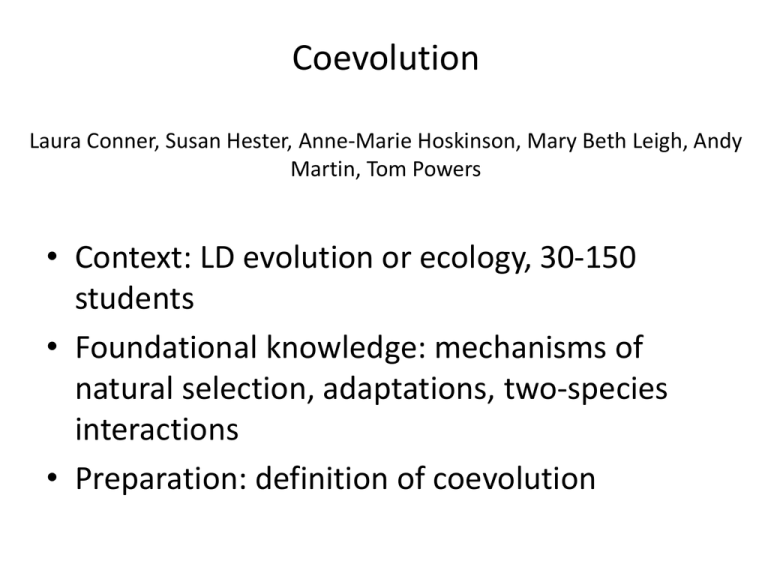
Coevolution Laura Conner, Susan Hester, Anne-Marie Hoskinson, Mary Beth Leigh, Andy Martin, Tom Powers • Context: LD evolution or ecology, 30-150 students • Foundational knowledge: mechanisms of natural selection, adaptations, two-species interactions • Preparation: definition of coevolution Unit learning goals: • Understand that species interact on an evolutionary time scale • Know that other organisms can be powerful agents of selection Unit learning outcomes: 1. Define coevolution. 2. Identify types of evidence that would help determine whether two species are currently in a coevolutionary relationship. 3. Interpret and draw graphs. 4. Evaluate evidence about whether two species are coevolving. 5. Make testable predictions based on the hypothesis that two species are coevolving. 6. Predict the outcome of a perturbation to a coevolved system. Teachable tidbit learning outcome: 1. Define coevolution. 2. Identify the evidence that would help determine whether two species are currently in a coevolutionary relationship. 3. Interpret and draw graphs. 4. Evaluate evidence about whether two species are coevolving. 5. Make testable predictions based on the hypothesis that two species are coevolving. 6. Predict the outcome of a perturbation to a coevolved system. Coevolution requires… • Geographic overlap • Reciprocal effects on traits How is this coevolution? What happens to the gazelles when the cheetahs get faster? http://www.arkive.org/cheetah/acinonyx-jubatus/video-08c.html The Plot: In the Rocky Mountains, red squirrels and crossbills both eat lodgepole pine seeds. In some locations, squirrels are absent. The species interact when they occur in the same place … but do they have reciprocal effects on one another’s traits? Red squirrels Crossbill birds Lodgepole pine cone After http://evolution.berkeley.edu/evosite/evo101/IIIF1Casestudyofcoevo.shtml) Exhibit 1 From Benkman (2001) Evolution 55: 282-294. Exhibit 2 Upper CI* Survival Best fit line 1 = survived 0 = died Lower CI* Bill Depth (mm) From Benkman (2003) Evolution 57: 1176-1181. * CI = 95% confidence interval Value 9 8.8 8.6 8.4 8.2 8 7.8 7.6 7.4 7.2 7 Exhibit 3 Before crossbill predation After crossbill predation Cone Shape (width/length*15) Cone Mass (grams) Pine Cone Trait From Benkman (2003) American Naturalist 162: 182-194. Image credits: http://kuro-risu.blogspot.com/2010/03/american-red-squirrel.html http://www.learner.org/jnorth/tm/spring/GeneralistSpecialistDiscussion.html http://wormtracks.wordpress.com/2012/01/05/tree-of-the-month-lodgepole-pine/ Based on the data presented, ____________________ are in a coevolutionary relationship. (a) squirrels and pinecones (b) crossbills and pinecones (c) squirrels and crossbills (d) (a) and (b) (e) none of these species What kind of additional evidence would indicate a coevolutionary relationship between squirrel traits and pinecones? Make a prediction based on the hypothesis that pines are driving evolution of squirrel jaws. From Smith 1970. Ecological Monographs 40: 349-371 Exhibit 4 From Smith 1970. Ecological Monographs 40: 349-371 Learning Objective Active learning Assessment Diversity Evaluate evidence about whether two species are coevolving. • Case study • Group processing • Figure interpretation • Relationship map Formative: • Group processing about presence/direction of interaction • Clicker question • Video clip • Individual and group learning • Verbal, graphical, tactile information Summative: “Here are data for two species. Are they coevolving, or not? Why?”
